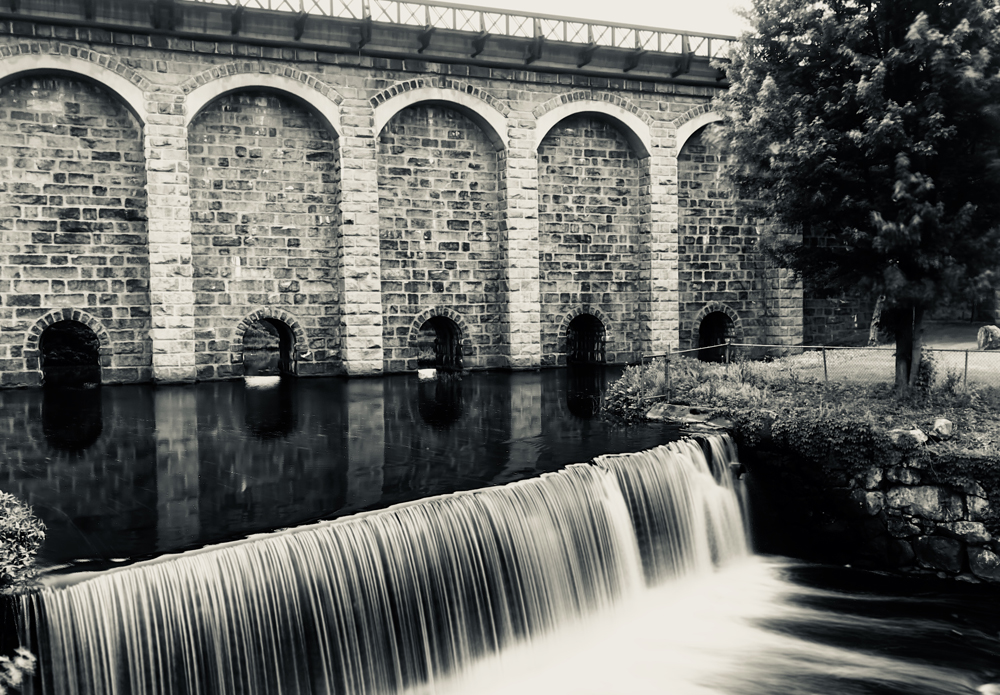True Tales from Canton’s Past: Secrets of the Viaduct
By George T. Comeau
Today the Canton Viaduct remains Canton’s most impressive National Historic Site. (Photo by George T. Comeau)
June 6, 1835. “The Viaduct at Canton, though yet unfinished, is a stupendous work. A view of it, many times repays the trouble of passage round … The Viaduct testifies in strong language to man’s dominion over nature … the road will stand for ages as an enduring monument of the high talents and high attainments of its accomplished engineer.”
Those words were written in the Providence Journal 183 years ago, and still true today. Within 10 years of it being built it was hailed as “the most elegant and massive structure of masonry in the United States.” Among the history of this town, the Canton Viaduct has endured as a national symbol to engineering, industry, and the place of the railroad in American history. It is a National Historic Site, and still we take the bridge for granite — who could resist? Granted. It has been at the center of the growth of this town since the day it was conceived. And given all we know about the bridge, there are still questions to be answered and tales to be told.
Originally, the railroad was conceived by Thomas B. Wales II. Wales was the eldest son of the senior Thomas Beale Wales (1776-1853). Born in Boston in 1808, he died there in 1863. Wales earned his money through inheritance; his father left him a considerable fortune, and in his 30s he became president of the Thomas B. Wales Company. As the third railroad chartered in Massachusetts, the Wales Company conceived of a 41-mile route for the Boston-Providence Railroad in 1831. The company also entered the American Clipper ship trade, visiting harbors throughout Europe, India and Asia.
Wales turned to a pair of young West Point graduates and civil engineers named William Gibbs McNeill and George Washington Whistler. If the latter name sounds familiar, it is because Whistler was the father of James Abbott McNeill Whistler, the famous American painter. In turning to McNeill and Whistler, the railroad was in the hands of two highly competent engineers at the birth of an industry. All told, they surveyed 11 slightly varying routes from Boston to the terminus in Providence. One of the most difficult routes was through Canton.
Canton posed an enormous cost and risk for the fledging enterprise. For one, the railroad would need to cross the vale of the Neponset River, and secondly, it would have to do so at a height of over 70 feet. Far better routes included that of what is now University Avenue in nearby Westwood. In fact, the track bed was laid out, but abandoned after Canton was the chosen route.
And why Canton? For one reason alone: Joseph Warren Revere, Paul Revere’s son and the president of the Revere Copper and Rolling Mill. Revere made his influence known through a pledge of $50,000 for stock and a seat on the board of directors of the B&P. The Viaduct was the result of a deal struck to ensure Revere had the first spur line in America. And so, on April 20, 1834, construction began. Stone quarried in Sharon and at a quarry just south of Messinger Street were brought to the site. Scottish Rite Freemasons cut each stone by hand and each one bears the symbol of the stonecutter. Irish masons set the stones in mortar that would last for centuries. Within 15 months and eight days, the Viaduct was complete. At a cost of $93,000 it was a magnificent sight to behold.
Recently the Canton Historical Society conducted a tour of the bridge for 20 local residents. Getting out of your car and touching and seeing the bridge up close is a far different experience than simply driving by. Up close you see the hand-hewn stones, the carver’s marks, and the sheer beauty of the lines. At 615 feet in length and more than 70 feet tall, the roar of the trains overhead cannot be felt as you touch the bridge. Largely, the tracks today “float” above the bridge with support hidden deep in the buttresses — which are actually transverse walls. The infill of the arches is largely ornamental. And, as most people have known, the Viaduct is a series of hollow chambers. The arches themselves only extend about four feet into the bridge on both sides and do not extend to support anything through the bridge.
As for secrets, there are many. Many people ask about a door into the bridge. And generations of parents and grandparents have told the story of not just the door, but also of going inside. The truth is far less interesting. No door has ever allowed access inside. And each cavity, 21 in all, are independent from the next. So entry into one gives access only to that one. There is no interior access unless a stone is removed. And over the past two and half centuries interior inspections have only happened twice. Those few men and women who have been inside are the fortunate few — this author included.
If you look at the wing walls on the north and south ends of the structure, you will see what appears to be stairs. It turns out that the bridge was completed only after the entire line was finished on both sides. In the summer of 1835, trains ran to the Viaduct abutments where passengers would exit and descend the embankment. Passengers crossed the river on a hand-operated cable ferry, boarded horse-drawn carriages on a temporary wagonway to cross the valley, then ascended the embankment to board a waiting train at the opposite abutment. The approach walls are believed to have supported the temporary (covered) train platforms to which wooden staircases were attached. These wooden staircases led from the train platforms to stone abutment staircases complete with railings for passengers to descend to the valley floor. A tintype from 1871 may have captured one of those walls at the north end, west side of the Viaduct.
There is still much to learn about the bridge. The lives of the men who built it and carved the stones are unknown to us. The plans, if they existed, have never been found. In the archives of the New York Public Library are dozens of letters written by Whistler, including some to his brother-in-law McNeill. In the years between 1829 and 1834 there are 13 letters in the archives. Letters written to Joseph Gardner Swift, who had been the surveyor of the Port of New York and in charge of the Baltimore and Susquehanna Railroad in Maryland.
In March 1829, Swift became the superintendent of the harbor improvements on Lake Ontario and held this position for 16 years. While the lake works were suspended in the winter of 1829, Swift took charge of the construction of the railroad from New Orleans to Lake Pontchartrain, five miles long through a dense swamp considered impassable, which could neither be drained nor piled. This was one of the pioneer railroads of the south and like the Canton Viaduct, it too proved man’s dominion over nature.
This fall, the Historical Society plans to offer more tours of the Viaduct and other historic sites in Canton. Secrets will be revealed.
Short URL: https://www.thecantoncitizen.com/?p=39058










